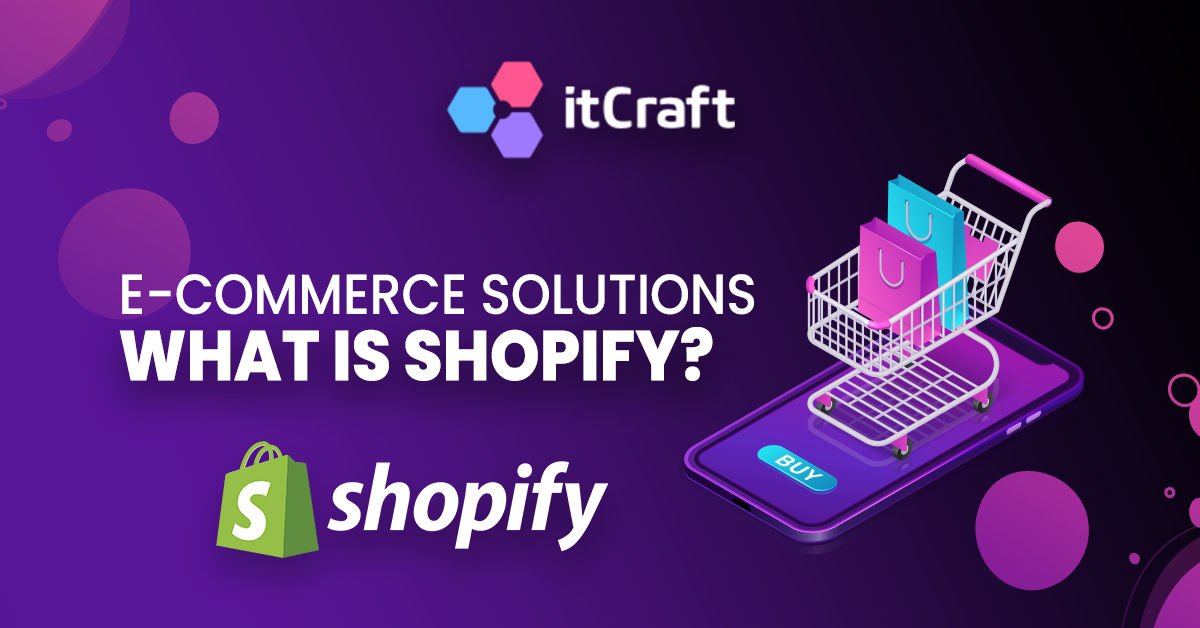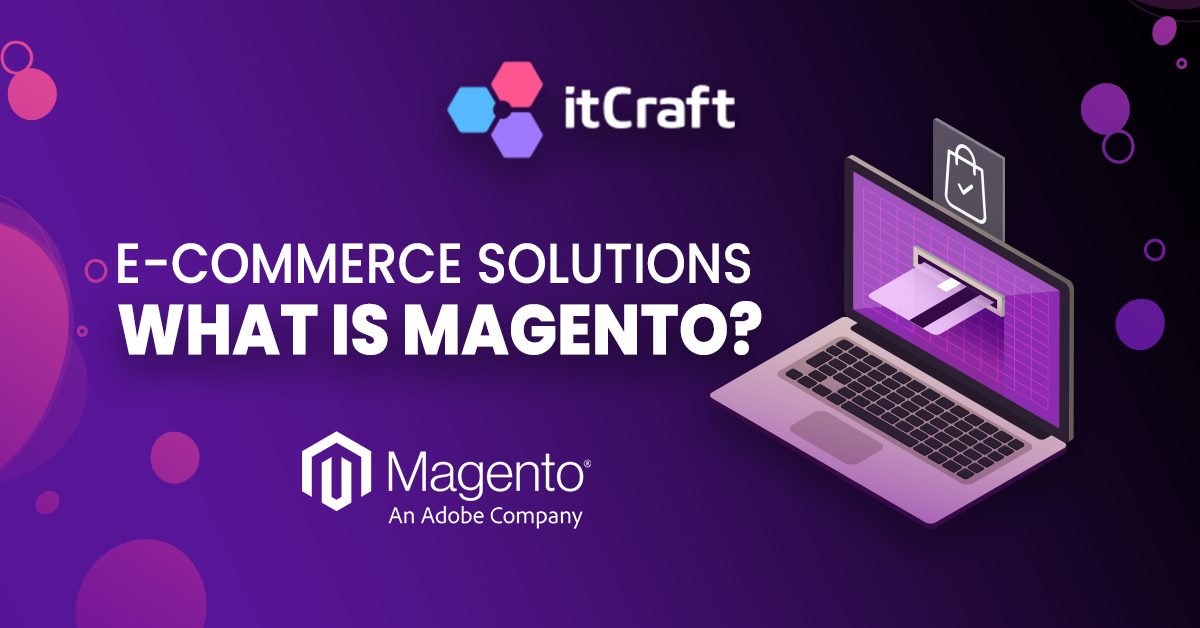eCommerce solutions – what is Shopify?

Alexa Trachim

Karol Wegner

The competition on the eCommerce platform market is fierce. Every merchant wants to have an online store that will work properly, load fast and provide advanced features for excellent user experience. In times of digitalization, every business that wants to be noticed should offer a robust solution for their clients. No matter what you sell, you should consider one of the best eCommerce systems to build your presence.
Table of contents
- What is Shopify?
- How does Shopify work?
– Do I need my own hosting?
– Shopify store – how much does it cost?
– Buy button
– Shopify Plus - Shopify features
– Shopify Payments
– Shopify Apps
– Shopify SEO
– Shopify Marketing Tools
– Shopify Multilanguage
– Shopify Sales Channels
– Shopify Support
– Shopify Analytics - Shopify pros and cons
– Pros of using Shopify
– Cons of using Shopify - Shopify store – is it for me?
Shopify might be just that. It is one of the top-rated products in the eCommerce realm. We will discuss why sellers and business owners highly appreciate it in this article. And since more than 1 million brands use Shopify to run an online store, there has to be something in it.
What is Shopify?
Shopify was founded in Canada in 2004 by Tobias Lütke, Daniel Weinand, and Scott Lake. Their first goal was to open an online store that would sell snowboarding equipment, but they weren’t impressed by eCommerce solutions available on the market. So Lütke, who happened to be a software developer, built the website on his own using Ruby on Rails framework. Then, in 2006 they released their platform called Shopify.
Basically, Shopify is a user-friendly system that is easy to configure and flexibly customizable online store creator. It provides useful tools and integrations for companies that want to digitalize their offline businesses or aspire to open an entirely new shop that will only be located on the web. In 2010 Shopify grew to offer mobile solutions and became truly comprehensive when it comes to eCommerce services.
How does Shopify work?
A Shopify store can be easily customized when it comes to design and functionalities. First of all, the users can choose from premade layouts and tweak them to meet their needs and requirements. That’s good news for everyone because it saves a lot of time and if you’re not tech-savvy, you can use a suitable template without worrying that you need to build the store from scratch. Designs provided by Shopify are optimized and they look aesthetic. The platform also offers video tutorials, so even a beginner will be able to learn how to build a store quickly.
After signing up, you need to login to Shopify and you can start using its intuitive interface. Adding features like order tracking, payment gateways, or product categories is not a problem. Using Shopify is not free, although there are a couple of payment plans that sellers can pick depending on their demands.
Do I need my own hosting?
Your Shopify store will be available on cloud-based hosting provided by the platform. That is excellent news because you don’t need to use third-party hosting – it’s convenient to have your eCommerce store in one place and pay for everything at once. All you need is a domain name and you can start building your website. Because Shopify is dedicated to eCommerce, it offers an optimized, scalable server that is set up to handle all amounts of traffic – which is crucial for every online store.
By the way, when it comes to a domain name – it is an additional cost, so don’t forget to put it in your budget. You can purchase one via Shopify or use external services.
Shopify store – how much does it cost?
First of all, before you decide on payment plans, make sure you start with a trial that lasts 14 days and unlocks all functionalities – so you can test Shopify inside and out. You don’t need a credit card to begin the trial, which is definitely a plus.
There are 3 Shopify premium plans you can choose from: Basic, Advanced, Shopify. Let’s see what the main differences between them are:

You can find detailed pricing on the Shopify website. Your choice should depend on your budget, the size of your online store and team and your needs for expansion. You can cancel your account anytime and upgrade your payment plan when your requirements evolve.
Buy button
If you already have a website or a blog, you don’t have to set up a separate online store to sell your products. Buy button is a feature provided by Shopify that allows creating product cards and checkout procedures within the existing website. It integrates with the most popular CMS systems like WordPress, Wix, Weebly and Squarespace. It’s a solution for entrepreneurs that want to add eCommerce to the portfolio of services they offer and for bloggers that want to monetize their brands.
Shopify Plus
Besides the premium plans for using Shopify, you can also move your business to its enterprise solution called Shopify Plus. It’s a platform for companies that observe a significant growth in their operations in the eCommerce area and need more sophisticated and advanced support for their online store.
The price is individual for every client and it’s based on revenue. A minimal amount is $2000. The fee for sellers that make more is 0.25% of sales volume per month.
The first big difference between Shopify and Plus is personalized support. Each account gets its own manager called Launch Engineer. They do not only help with setup or migration of the online store but are also available whenever things get tricky.
Shopify Plus also allows unlimited team members, so every corporation that hires a lot of staff to operate their selling processes will be satisfied with this solution. For more benefits, you should definitely check exclusive apps that expand the platform with unique features. For example, the Wholesale Channel allows to serve big B2B orders efficiently. There is also an application for eCommerce automation and many more.
With even more robust servers that can handle more than 10 000 transactions per minute, Shopify Plus is undoubtedly a powerful solution that will be perfect for big players. It can integrate with many well-known business platforms like ERPs and CRMs, gives the owner and the employees more control over the whole eCommerce process and produces more in-depth reports. Use Shopify Plus, if you are predicting significant expansion anytime soon. Use the ordinary one if you are a small business, or you are just starting your journey into the eCommerce world.

Shopify features
To give your customers a genuinely positive experience when they visit your store and buy your products is to make sure you provide them with everything they desire. Buying stuff online should be simplified with multiple payment methods and a secure checkout process. Your website should also allow advanced searching and all the available goods should be sorted the way that will be intuitive and understandable.
If you take care of all the above, you can expect success. So we should discuss a couple of features that Shopify has. Their purpose is to deliver better performance, but also to make your store truly user-friendly.
Disclaimer: remember that some functionalities differ, depending on the Shopify plan you pick. For example, the most expensive subscription automatically counts shipping rates and has more advanced analytics.
Shopify Payments
This is a feature that allows to accept payments (for example, using a credit card) and it comes as a built-in option with your Shopify account. So you don’t need to seek for payment gateways from other merchants or systems, everything is integrated with your store on Shopify. By the way, it is worth mentioning that if you instead use external payment methods, Shopify will charge transaction fees for every order processed by your store. That can be a disadvantage, but you should test Shopify Payments first and see if it meets your requirements. Transaction fees can be particularly problematic for sellers placed in other countries than the US because Payments functionality does not work in every location.
Other than that, Shopify allows to accept all credit card providers, track payment balance and use chargebacks in case of any issues. If Shopify Payments is available in your country, you should definitely give it a try. Maybe you will be able to dodge the transaction fees.
Shopify Apps
Shopify has its own app store that allows expanding the platform’s features even more. These extensions are countless and they are dedicated to many solutions – marketing, wholesale, dropshipping, integrations and much more. Instead of developing each functionality separately, you can use a Shopify design template and complement it with suitable apps.
There are around 1000 free extensions and the rest are paid. You should pay attention to the reviews – they will tell you a lot about the quality of the particular app. Some apps are developed by Shopify itself (for example, social media integrations), but others are created by the community. That’s why finding a high-quality app is so essential – you don’t want to lose your money on a tweak that won’t work correctly.
Shopify SEO
Search engine optimization is crucial for every online business, not exclusively eCommerce. To make your website visible in Google, Yahoo, or Bing, you need features that will allow it to be read and ranked by search engine bots. Does Shopify offer any SEO facilitations? Yes!
First of all, Shopify has an intuitive system for setting up tags, categories meta descriptions and other SEO elements for all pages and products you introduce into your store. Categorization is overall a great way to boost SEO, although Shopify doesn’t offer sub-categories, which can be painful for more seasoned optimization enthusiasts.
Redirecting URLs is useful for migrations and offers changes, as Shopify automatically will move the customers that enter the page with the wrong web address to the right one. It means that if we change the URL of a particular product, Shopify will always redirect people on our website to the new one, even if they access the old one, for example, via not updated search engine results.
Speaking of URLs, these are not entirely customizable, which is a small disadvantage – for example, product pages will always have a “product” section within their URLs.
In general, SEO support in Shopify is quite good, especially for beginners. And what about marketing and content?
Shopify Marketing Tools
Shopify shares a bunch of different tools and methods for marketing, blogging and content creation to grow sales and promote the brand online.
Shopify provides an easy system for discount code creation. You can use different parameters to give your customers individual codes for all kinds of products. The same applies to gift cards. When it comes to loyalty programs, though, you need to get an additional app that will enable that functionality.
Shopify also has a simple, pre-installed email system, but you can also use alternatives as it doesn’t offer many features. Also, as we mentioned, Shopify has excellent integration with social media portals.
One of the most impressive marketing instruments that you can find in the Shopify system is abandoned cart recovery. It means that the platform allows the seller to send messages to people that added products to their cart but never placed the order. If we have the client’s email address in our database, we can send them a discount code after visiting our website. If you don’t have the email, you can still create popups and banners that will encourage the clients to come back and purchase the products they were considering.
When it comes to a blog, it is integrated with the store and Shopify provides a simple yet a little bit old fashioned CMS that is incomparable with WordPress but allows to create and publish content. It has customizable SEO, tags and can be written by more than one author. If you need something more advanced, than you should explore other options that require slightly more effort – but for basic needs, this blogging platform should be enough.
Shopify Multilanguage
If you want to use Shopify to sell internationally, you will appreciate the fact that it has excellent multi-region features. Why having a store only in English is not a good idea? You can reach more customers if you share information about your products in their native languages. And that will influence the number of your sales. Also, not everybody knows English so these clients won’t be able to purchase anything and you will lose them.
The translated content should be placed on separate URLs, or you can use a dedicated app to simplify the process of building a multilingual website.
Shopify Sales Channels
Besides your own eCommerce store, you can sell your products using platforms like Facebook, Instagram and Pinterest. Shopify also integrates with Google Shopping, eBay, Amazon, and many other sites that allow to purchase products directly from their premises. It can be another way to gain more clients.
Shopify Support
When you use a Shopify store for selling products, you will probably need some help at one point. You can get it 24/7 via phone and that’s one of the advantages of using Shopify. Besides that, you can contact customer care on social media profiles, send an email or talk on live chat that is also available all day every day. Shopify Help Center is full of useful tips and quick answers that might be your first aid when you stumble upon a problem.
Some people are not satisfied with response time, but if you pick this platform to open your eCommerce store, Shopify support will be an instance you will have to face. There are many ways of contacting them, so maybe you won’t have to wait too long for your issue to be fixed.
Shopify Analytics
Last but not least, analytics and reporting. It all depends on the pricing plan you pick initially. Still, everyone gets a dashboard to overview their results, finances report with taxes and payments, real-time reports, analysis of key metrics like sales and orders, basic customer behavior statistics like conversion rates and simple marketing data. The more expensive Shopify subscription you invest in, the more detailed information you get. Still, you always get some kind of reporting, so that’s a plus.

Shopify pros and cons
As you can see, Shopify is a rather sophisticated tool for people who want to sell products online. Every eCommerce business owner wants to offer perfect service to its customers. But there is no ideal solution – you need to remember about that. When picking a platform for your store, you need to make sure it will meet your needs. What Shopify has and what can’t be found in it? See for yourself.
Pros of using Shopify
- Beginner-friendly – if you want to start selling products online and you are not sure how to do it, Shopify is great for beginners and very easy to use.
- Premade themes – the selection of designs is impressive and they shorten the process of creating the store.
- Integrations – Shopify has countless apps, add-ons and can integrate with many other platforms.
- Scalability – Shopify is a solution suitable for small online shops and big eCommerce enterprises.
- Loading speed – websites built with Shopify are secure, fast and their performance rates are very satisfying even when traffic significantly grows.
Cons of using Shopify
- Costs – you need to pay a monthly fee that for some sellers can be quite high.
- Transaction fees – if you want to use external payment gateways (and Shopify Payments is not available everywhere so you might have no choice), you need to pay for each order and that adds to the mentioned costs.
- Slow support – many people claim that response times are too long.
- URLs – the structure of addresses is not perfect SEO-wise.
Shopify store – is it for me?
Every person that wants to sell products online should remember many things – creating an intuitive design, providing credit card payments, setting up shipping rates, planning a content marketing strategy, etc. Shopify delivers a complex system that simplifies many of those activities.
To use Shopify, you don’t need advanced development knowledge because it provides layouts and templates with straightforward customization options. That can be an excellent option for beginners and merchants that are looking for non-complicated solutions.
At the same time, every platform of this kind has its limitations and you won’t be able to achieve fully personalized results without coding skills or a programmer’s help. If you need a complete eCommerce website to offer your products or services – we recommend reaching out to a software house. At itCraft, we can create custom software that will give your clients a positive experience when buying goods via web and/or mobile. Let us know what you have in mind and we can take your project idea to make it a reality. We work with startups, small brands, big enterprises, and international corporations, so we know how to address our clients’ diverse needs.



